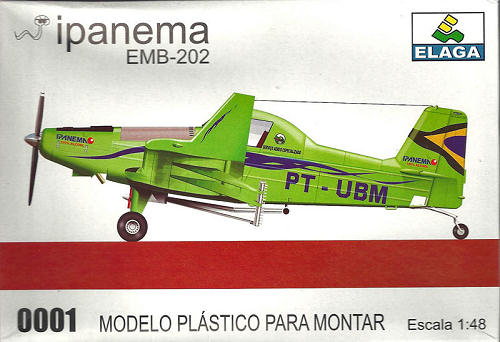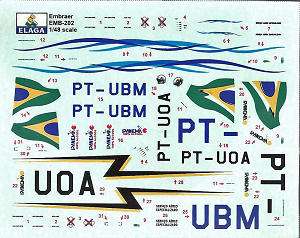
Elaga 1/48 Embraer EMB-202 Ipanema
| KIT #: | 0001 |
| PRICE: | $ |
| DECALS: | Two options |
| REVIEWER: | Andrew Abshier |
| NOTES: | First injection-molded kit by this manufacturer |

| HISTORY |
"In the 1960s, the development of a Brazilian agriculture aircraft was motivated by the expansion of agricultural products' market, specifically soybean and sugar cane. During this time, the Ipanema aircraft was developed by engineers of the Aeronautics Technological Institute (ITA) on the Ipanema Farm, located in Sorocaba.
The first version of the aircraft, the EMB-200, made its first flight in 1970 and was certified in December 1971. The aircraft was equipped with a 260 HP piston engine. Series production started in 1972 by Embraer. In September 1974, the EMB-201 was introduced, including many improvements such as a 300 HP engine, new propeller, new wings and increased capacity.
In 1982, the production of Ipanema was transferred to Indústria Aeronáutica Neiva, recently acquired by Embraer. In 1992, a new model, called EMB-202 or Ipanemão, was released. The new aircraft had improvements on aerodynamics, a 40% greater capacity, and an optional, modern equipment for electrostatic aerial application.
In the following years, Neiva made significant improvements on the aircraft, such as adding winglets to the wing tips, adding an air conditioning system to the cabin, lowering the position of the wings, decreasing the resistance and reducing the weight of the exhaust system.
Since ethanol is largely available in Brazil, costing only about 25-30% as much as aviation gasoline, many Brazilian farmers have attempted to fuel gasoline-powered Ipanemas with alcohol, with varying degrees of success. The result of this was the development of an alcohol-powered Ipanema, which was certified by the Brazilian General Command for Aerospace Technology (CTA) on October 19, 2004. The Ipanema engine had also 20% lower maintenance and operational costs."
| THE KIT |
 Elaga Models iss the brainchiled of Joao Elaga, who had been manufacturing
airbrushes for the Brazilian market under the Lince brand. As far as I can
determine, this is the first kit ever, in any medium, of a modern American-type
aerial application aircraft. This is also the first kit to be produced by this
company, so that makes two historic firsts in one kit!
Elaga Models iss the brainchiled of Joao Elaga, who had been manufacturing
airbrushes for the Brazilian market under the Lince brand. As far as I can
determine, this is the first kit ever, in any medium, of a modern American-type
aerial application aircraft. This is also the first kit to be produced by this
company, so that makes two historic firsts in one kit!
The kit is molded in gray plastic with a total of 60 parts (57 gray, 3 clear). There was some flash on my sample, but no sink marks. There was some slight mold mismatching on the grab handles and spray bars noted on my sample.
Surface detail, other than engraving for the control surfaces and access panels, is all raised rivets, which is actually accurate for this aircraft; the rivet detail does seem overdone, especially on the tail surfaces, and some light sanding down should be done to reduce it.
The cockpit is very simplified, with a seat, stick, and instrument panel only. There is no bezel detail on the instrument panel, so you'll need Reheat or Mike Grant Decals instrument bezels to help. The seat has the seatbelt molded on, but this can be shaved off and tape or PE seatbelts substituted. A little modeling skill and help from the spares box can do the rest.
Clear parts are of reasonable quality, but include only the cockpit glass; for some reason the landing light covers for the wings were omitted! You can probably fabricate landing light covers from clear sprue. A dip in Future will definitely help the clear parts.
Dryfitting revealed component fit that was OK, not great. It will be a challenge to get seams finished while preserving the rivet detail, so plenty of trimming and dryfitting should be performed before cementing.
 The instructions are entirely in Portuguese, but the drawings are very clear
on what goes where.
The instructions are entirely in Portuguese, but the drawings are very clear
on what goes where.
Decals are supplied for two aircraft:
PT-UBM, an ethanol-fueled overall lime green aircraft
PT-UOA, in overall red
The decals on my sample were not consistently well printed; two of the four no-step symbols and one of the Brazilian flag designs appeared to be off-register. These appear to be from a different manufacturer than the notoriously cranky Brazilian-printed FCM decals, but I would test them using unneeded designs on a scrap model before using them on the Ipanema.
| CONCLUSIONS |
This kit reminds me of an Airfix kit from about the late 1960s with the rivet detail, good but not great molding quality, OK fit, and simplified details. On the plus side, it appears to be accurate in outline, the "bones" that are there look good mostly, and with some TLC and extra detail you'll get an interesting and unique model to add to your collection. If you build the lime green version, NO ONE will miss it when you take to a club meeting or contest!
Recommended for experienced modelers.
| REFERENCES |
http://en.wikipedia.org/wiki/EMB-202_Ipanema
Ipanema walkaround photos: http://www.spruemaster.com/blog/index.php/2010/03/walkaround-embraer-emb-202a-ipanema/
May 2010
If you would like your product reviewed fairly and quickly, please contact me or see other details in the Note to Contributors.